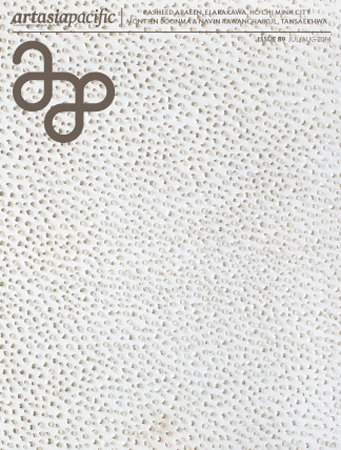ArtAsiaPacific
July/August 2014
Out now
The July/August issue of ArtAsiaPacific looks back at some of the most important artistic figures and movements from Asia after World War II, a period that witnessed the emergence of alternative art practices as well as much of the visual language that we take for granted today.
Our cover story, “Beyond White: Reading Tansaekhwa Today” by Robert Liles, introduces a controversial movement associated with a loosely connected group of South Korean painters active from the late 1960s. Liles explores Tansaekhwa (“monochrome painting”), the work made by the participating artists and the debates surrounding the cultural significance of their distinct style in the aftermath of the Japanese occupation of Korea (1910–45) and the Korean War (1950–53).
From London, Stephanie Bailey meets Pakistani-British artist Rasheed Araeen, a pioneering spirit who, in the 1960s, made some of the earliest Minimalist art and later penned stinging critiques of Western hegemony in the arts and social sciences in Europe.
In a poignant reminder of the passage of time, Thai-Indian artist Navin Rawanchaikul wrote a letter that formed part of the group exhibition Spiritual Ties, a tribute celebration for Montien Boonma (1953–2000), on what would have been his 60th birthday. Dearest Montien (2013), which we reprint in full, describes the Thai art scene since the artist’s death more than a decade ago, and the sociopolitical and spiritual impact Montien, as artist, teacher, mentor and friend, has had on the tight-knit art community.
Also looking back in time, Hong Kong artist Lam Tung-Pang created “What Is Disappearing” for our special feature column Inside Burger Collection. Sparked by his project Ghost – Disappeared Hong Kong Art (1): 90s, Kurt Chan, originally commissioned and produced by Burger Collection for their exhibition I Think It Rains (2013), here Lam expands the series, which explores ephemeral installations from 1990s Hong Kong that endure only as faint recollections in the form of slides and catalog illustrations.
In our artist and collector profiles, we look at the careers of Australian collector and philanthropist Gene Sherman, and Indian photographer Anup Mathew Thomas. Guest contributor Taro Masushio meets performative artist Ei Arakawa, and contributing editor Isabella E. Hughes speaks with Doha-based Iraqi artist Mahmoud Obaidi about his concept of home.
In Essays, associate editor Sylvia Tsai attends Sharjah Art Foundation’s annual March Meeting and considers its agenda of how artists might build communities and social consciousness through their practice. Similarly, assistant editor Ming Lin heads to China to look at an off-beat project, “Social Sensibility”—at French-owned hi-tech manufacturer Bernard Controls—which encourages artists, designers, musicians and other creatives to stage events on its Beijing premises. Rounding out the section, managing editor John Jervis contemplates the evolution of Hong Kong’s art scene through Hanart TZ Gallery’s 30th anniversary exhibition, Idiosyncrasies, featuring 100 works from owner Chang Tsong-zung’s personal collection.
For One on One, Hong Kong artist Lee Kit offers some notes about his obsession with a mysterious character named Johnny, who seems to be everywhere and nowhere in the artist’s dreams. For Where I Work, we head to Dubai to visit the convivial mash-up that comprises the home-studio of three artists, Ramin Haerizadeh, Rokni Haerizadeh and Hesam Rahmanian. Dispatch takes us to Ho Chi Minh City, where our new desk editor, Ruben Luong, explains the art scene’s recurring cycles of optimism and disappointment, which compel the young and growing community of local artists to confront and mine their pre- and postcolonial histories, and to create something sustainable for the future. And in Fine Print, art lawyer Sergio Muñoz Sarmiento playfully considers why artists destroy or damage artworks, and if their acts of vandalism might be interpreted as “art.”
Select articles now online in Arabic and Chinese: artasiapacific.com
Subscribe to the print edition, buy digital copies on iTunes, Zinio or Magzter, and follow us on Facebook, Twitter and Instagram.
